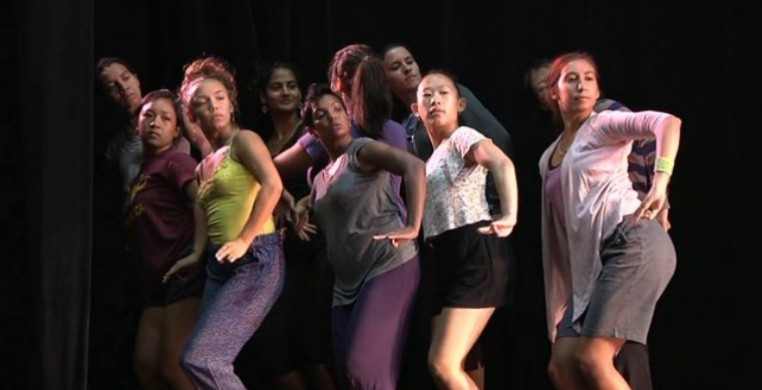There are dreams and there are nightmares. The Minneapolis-based troupe Ananya Dance Theatre has gamely tried to digest the two in its 90-minute work, “Neel: Blutopias of Radical Dreaming,” often with curious results. The company concluded its performances of “Neel” on Sunday at Links Hall.
Created by company founder Ananya Chatterjea, “neel” means “blue” in Bengali, Chatterjea’s native language. Red seemed the more appropriate color. “Neel” is an exploration of rather grim themes, an audacious yet muddled portrait of the subconscious. On the surface, this highly energized performance aims to portray dreams as a wellspring for motivation, specifically from the perspective of women. There’s reference to the oppression of indigenous cultures, rendered in an almost-maniacal manner through tears and violence. To be sure, Chatterjea’s creation hopes to achieve its self-described radical tendencies through shock-and-awe tactics, plodding through its scenes and appearing anything but dream-like; death practically lurks at every turn and the generalities run wild. The final product is probing, if not alternately moody in its tone.
We’re helped along through the program notes, which describes “Neel”’s dance-theater combo as a work about “women’s dreams: dreams that unleash tremendous joy; shattered dreams; the imaginative labor that conjures up the most unlikely but exciting dream-visions; and dreams of wholeness and freedom that sound the call for revolution.” The revolution, however, never came to fruition; most sections suggested disaster: fragmented scores, graphic metaphors (including the miming of what appeared to be a miscarried pregnancy), and at one point, shrill shrieking through long metal poles. Its purpose was lost on me and overshadowed Chatterjea’s rather inventive movement. Perhaps part of this feeling is due to the title itself, suggesting a sense of optimism more than anything else. It was therefore hard to buy into so many convoluted ideas.
“Neel” actually opens in peace. The dancer’s initial formations bring to mind lush trees blowing in a calm wind. Chatterjea’s practice was at its best here, an intricate blend of traditional Indian dance, modern technique and hints of martial arts. The dream begins quietly before the sounds of gunshots kill everything in its wake. As if crawling from their graves, the dancers find their way into various situations, most prominently in a series of duets that could be both engaging and overly literal. A vivid pairing occurs between Chatterjea and another company dancer, who covers Chatterjea’s throat in red powder, as if to imply the cutting of her throat. The moments of calm seemed few and far between.
“Neel”’s fluctuating world, mimicking the piecemeal form that dreams often leave us analyzing, is unsure of itself. The progression begins with an execution and ends abruptly with an optimistic—and somewhat misplaced—celebration that invites the audience to join together and realize their own dreams. Breaking that boundary did little to satisfy.

